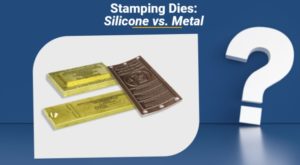Silicone vs. Metal Hot Stamp Dies
A comparison
Silicone vs. Metal Hot Stamp Dies

What are the differences between silicone vs. metal hot stamp dies? Which one is better suited to your product decoration needs? This post will give a short, medium, and long answer to that question.
A SHORT ANSWER: Simple Rule of Thumb
We will start with the short answer. A good rule of thumb – requires a quick look at the substrate or material you wish to decorate.
If you have a RIGID substrate to decorate: You will likely need a FLEXIBLE Silicone Die.
If you have a FLEXIBLE substrate to decorate: You will likely need a RIGID Metal Die.
A MEDIUM ANSWER: Benefits Comparison

A slightly longer answer to this question requires a look at the similarities and differences between silicone and metal dies. Both silicone and metal stamping dies provide high-impact decoration with metallic, holographic, or prismatic hot stamp foils.
There are some key differences as well, however.
Silicone Dies, for example, are:
-More cost-effective than steel or brass dies
– Require less stamping pressure than metal dies
– Provide better conformity to slight surface variations
– Avoid plastic deformation around the artwork area
On the other hand, metal dies have their own list of performance benefits. These include:
– The ability to provide an embossed visual effect
– Compatibility with higher printing speeds
– Longer life and the metal materials are more durable
A LONGER ANSWER: In-Depth Comparison
| Rubber Dies | Metal Dies | |
| Materials Available | Various for specific applications – high temperatures, quick heat recovery, & high strength | Magnesium Copper Brass Steel |
| Average Die Life | Contoured – X Flat – 2X |
Magnesium – Y Copper – 4Y Brass – 18Y Steel – 20Y+ |
| Surface Variations (sinks) | Will Compensate | No Compensation for Sinks |
| Variation in Material Thickness | Will Compensate | No Compensation |
| Set-up Time | Quick Process | Lengthy Process |
| Pressure Requirements | 350 lbs. Per sq. inch (HS) 500 lbs. Per sq. inch (HT) |
1000 lbs. Per sq. inch |
| Temperature Requirements | 100F > Metal (approximately 300-400F) |
100F < Rubber (approximately 250-300F) |
| Dwell Time | 50% > Metal | 30% < Rubber |
| Decorative Finish | Foil/Transfer lays on top of substrate | Imbeds foil/transfer into surface |
| Price | Initial Set-up/Mold Charge Die Cost < Metal |
No Set-up/Mold Charge Magnesium – $ Copper – 2X $ Brass – 8X $ Steel – 10X $ |
| Substrates *indicates preferred material |
ABS Acetal Acrylic Polyamide (Nylon) Polycarbonate Polyethylene Polystyrene PVC – Plasticized PVC – Rigid* SAN* UV Coating Epoxy / Epoxy Coating Polyurethane Wood |
ABS Acetal* Acrylic Leather* Paper* Polyamide (Nylon)* Polycarbonate* Polyethylene* Polystyrene PVC – Plasticized PVC – Rigid SAN UV Coating* Epoxy / Epoxy Coating Polyurethane |
Would you like to know more?
Please get in touch. We would love to hear from you.